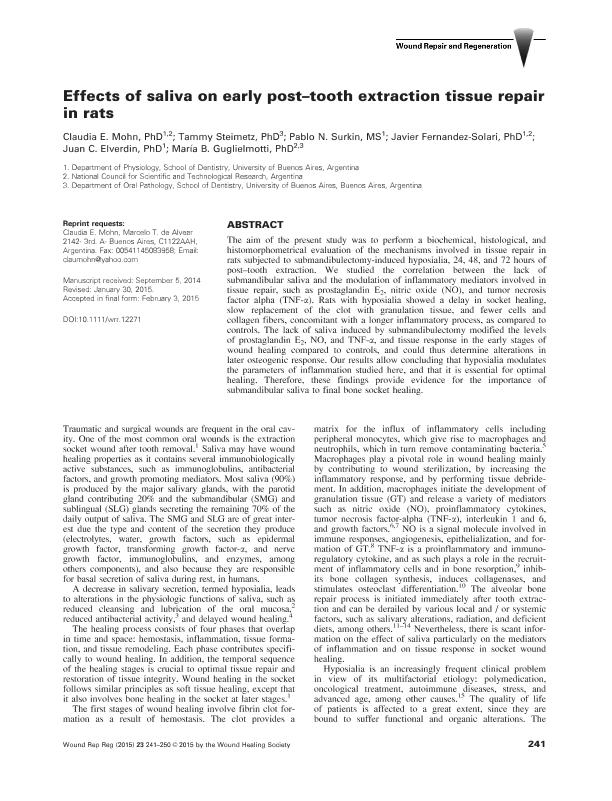Artículo
Effects of saliva on early post-tooth extraction tissue repair in rats
Mohn, Claudia Ester ; Steimetz, Tammy; Surkin, Pablo Nicolas
; Steimetz, Tammy; Surkin, Pablo Nicolas ; Fernández Solari, José Javier
; Fernández Solari, José Javier ; Elverdín, Juan Carlos; Guglielmotti, Maria Beatriz
; Elverdín, Juan Carlos; Guglielmotti, Maria Beatriz
 ; Steimetz, Tammy; Surkin, Pablo Nicolas
; Steimetz, Tammy; Surkin, Pablo Nicolas ; Fernández Solari, José Javier
; Fernández Solari, José Javier ; Elverdín, Juan Carlos; Guglielmotti, Maria Beatriz
; Elverdín, Juan Carlos; Guglielmotti, Maria Beatriz
Fecha de publicación:
03/2015
Editorial:
Wiley Blackwell Publishing, Inc
Revista:
Wound Repair And Regeneration : Official Publication Of The Wound Healing Society [and The European Tissue Repair Society.
ISSN:
1067-1927
Idioma:
Inglés
Tipo de recurso:
Artículo publicado
Clasificación temática:
Resumen
The aim of the present study was to perform a biochemical, histological, and histomorphometrical evaluation of the mechanisms involved in tissue repair in rats subjected to submandibulectomy-induced hyposialia, 24, 48, and 72 hours of post-tooth extraction. We studied the correlation between the lack of submandibular saliva and the modulation of inflammatory mediators involved in tissue repair, such as prostaglandin E2, nitric oxide (NO), and tumor necrosis factor alpha (TNF-α). Rats with hyposialia showed a delay in socket healing, slow replacement of the clot with granulation tissue, and fewer cells and collagen fibers, concomitant with a longer inflammatory process, as compared to controls. The lack of saliva induced by submandibulectomy modified the levels of prostaglandin E2, NO, and TNF-α, and tissue response in the early stages of wound healing compared to controls, and could thus determine alterations in later osteogenic response. Our results allow concluding that hyposialia modulates the parameters of inflammation studied here, and that it is essential for optimal healing. Therefore, these findings provide evidence for the importance of submandibular saliva to final bone socket healing.
Palabras clave:
Hyposalivation
,
Salivary Glands
,
Surgery
,
Wound Healing
,
Inflammation Mediators
Archivos asociados
Licencia
Identificadores
Colecciones
Articulos(OCA HOUSSAY)
Articulos de OFICINA DE COORDINACION ADMINISTRATIVA HOUSSAY
Articulos de OFICINA DE COORDINACION ADMINISTRATIVA HOUSSAY
Citación
Mohn, Claudia Ester; Steimetz, Tammy; Surkin, Pablo Nicolas; Fernández Solari, José Javier; Elverdín, Juan Carlos; et al.; Effects of saliva on early post-tooth extraction tissue repair in rats; Wiley Blackwell Publishing, Inc; Wound Repair And Regeneration : Official Publication Of The Wound Healing Society [and The European Tissue Repair Society.; 23; 2; 3-2015; 241-250
Compartir
Altmétricas



